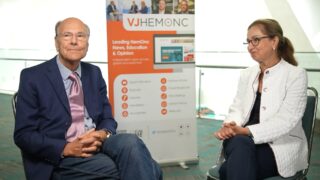This is something which is an unexpected observation that we have, particularly with bispecific antibodies, the highest infection rate ever reported in myeloma. And there are different problems. When you report infection rate, we should also take the duration of follow-up into account. So at this point in time, this is not clear when you look at different studies, because some studies present infection rate of, let’s say, 45%, but they have a follow-up duration of four months...
This is something which is an unexpected observation that we have, particularly with bispecific antibodies, the highest infection rate ever reported in myeloma. And there are different problems. When you report infection rate, we should also take the duration of follow-up into account. So at this point in time, this is not clear when you look at different studies, because some studies present infection rate of, let’s say, 45%, but they have a follow-up duration of four months. And the teclistamab study has an infection rate of close to 80%, but the follow-up was 18 months. So we have to normalize the infection rate for the duration of observation, number one. And secondly, and that is also something we should consider, we have to accept that patients may have not only one infection during the course of treatment with bispecific antibodies. They actually may have several infections. So that should also be recorded in order to get a complete picture. Who are the patients at particular risk for repeated infections? And what are the consequences of infection? And the next big question is, of course, what can you do to reduce the risk of infections?
And actually, our presently available tools are limited. We can, of course, improve IgG levels in those patients. Most of those patients have low IgG levels, particularly those patients who are on BCMA targeting treatment because BCMA is present not only on myeloma cells, but also on B-cells and normal plasma cells. So when you use a treatment which targets BCMA, you wipe out all your B-cells. You wipe out most of your normal plasma cells, so you’re left with nothing other than low IgG level. So you can easily supplement this. That’s easy. And when you do this, you improve patient situation. You reduce the risk for severe infections, depending on the study, by up to 80%. So that can be done.
What else should be done? You can, of course, vaccinate your patients. But usually it’s too late, or it’s very late to vaccinate a patient who is progressing and whom you want to treat with bispecific antibodies, or CAR-T. So, you can do this, it’s better than nothing. So, there are several experts who recommend vaccinating your patients. There are five must-haves. It is, of course, influenza, it is herpes zoster, it is pneumococci, it is COVID, and the next, the new one in this row is respiratory syncytial virus. So we have five vaccines which should be offered, but we have to acknowledge that the clinical circumstances often hinder a proper vaccination strategy. But it’s better than nothing. And we know from there’s a new study which has recently been published with using influenza vaccines in myeloma patients. And usually, and that is the same, is true for COVID, it’s not enough to vaccinate only once, because the immune system is very weakened. But when you vaccinate repeatedly with the same vaccine, you get a better immune response. So that can be done.
And of course, you have to be proactive when patients report symptoms. And patients tell you suddenly since this morning I feel very fatigued, something has happened, I’m weak. So you should think of a possible bloodstream or other infection. Those patients you should use the diagnostic armamentarium. It’s important to check CRP levels and to investigate the patient in greater detail because you may find out that there is an infection. This is also true for patients who report night sweats. They usually have an infection, a viral infection. So if you ask those patients these critical questions, you will then get a positive response. You then are required to look for viral and bacterial infections and very frequently you actually will find out there is an ongoing infection and then you can start treatment immediately. So time is important. The time between the onset of symptoms or reporting of symptoms, diagnostic tests and installment of appropriate treatment.
This transcript is AI-generated. While we strive for accuracy, please verify this copy with the video.















